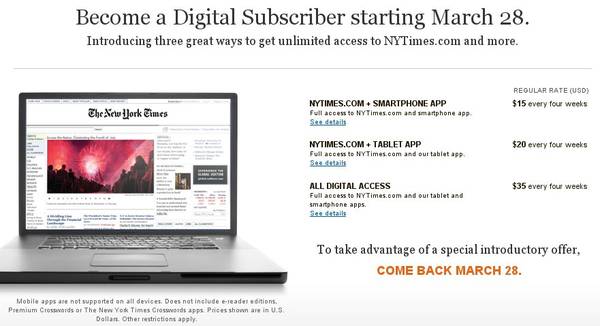So what have people been saying about the New York Times paywall (or fence, ramp, meter, porous paywall, nagwall or even ‘metered-access digital subscription system’, if you prefer)?
It was announced yesterday that the paywall is going up on March 28. A metered system will allow readers to access 20 articles a month for free and it will be free for those who land on a page via a link from Twitter, Facebook, a search engine or blog.
So, how much money will it make? paidContent has done the maths and reckons around 500,000 people will sign up, generating $100 million.
And what is everyone saying about it?
Online Journalism Blog is encouraged that the NYT model will work, as it recognises the importance of distribution (via Twitter and Facebook) and balancing quantity with quality for advertisers.
Newsonomics thinks the timing is good, coinciding with the launch of the iPad 2 in America.
The Nieman Journalism Lab says the NYT faces seven tests if it is to succeed.
The Online Journalism Review is encouraged by the business model but thinks customers will go elsewhere for news.
10,000 Words looks at paywall models and compares NYTs strategy with the Wall Street Journal and Newsday.
Poynter takes a look at tweets on the subject (including some quite funny ones like “If the NYT paywall gets torn down, Reagan will probably get credit”).
The Cutline looks at what readers of the NYT think of it (not much, judging by many of the comments).
One of the most interesting points is made by TechCrunch, which says the pricing structure is unfair and “discriminates by device” (The NYT’s charging $15 a month for web access, $20 to add smartphones or a an iPad, and $35 for all).
In other words, if you are shelling out $20 a month for the iPad subscription, and you want to also be able to read it on your iPhone, you basically have to pay the full smartphone subscription price, or an additional $15 a month. That seems like a rip-off. A digital subscription should be a digital subscription, and it shouldn’t matter what kind of computer you use to read the paper on. But okay, the iPad and other tablets are different, I might pay a little more for the tablet apps. But once I step up to pay the New York Times $20 a month for its iPad app, that should include access via the iPhone app as well.
Scripting also makes an excellent point about “frequent linkers”, who will have to pay to deliver readers to the NYT.
They did something smart in not charging readers who get to a Times story through a link from a blog post or tweet. But – since I am a frequent linker, I wonder why I should pay to read their site, when I’m delivering flow to them. How does that equation balance by me paying them? Maybe they should pay me? Seriously.
Elsewhere on paidContent, Bill Grueskin, former managing editor of the subscription-based Wall Street Journal Online, predicts the NYT can expect a big number of early subscribers.
He is also one of many to point out that there are ways over the wall.
According to sources close to the situation, the 20-story limit can be breached if you access the site from multiple devices, and/or if you delete your cookies. In other words, suppose you hit the wall on your PC. Then move to your laptop, where you’ll get another 20 stories. Delete your cookies on any computer, and the clock goes back to zero.
Roy Greenslade has also been reading about how to jump over the wall: by finding a story, pasting the headline into a search engine and accessing the linked story for free.
Perhaps the most revolutionary way to sneak around the wall is this idea is reported in the the Atlantic.
So, cheapskates, meet @freenyt, a three-hour old Twitter feed that intends to tweet all the Times stories.
That works as articles linked via twitter are free. But the article does point out:
Maybe we can even think of the Times paywall as akin to old-school shareware that didn’t force you to upgrade but just hit you with a nag screen (a nagwall?).

Pingback: Sign of the Times: Content Professionals Weigh in on the NYT Paywall - Engage